定语从句中的介词问题
定语从句 知识讲解 “介词+关系代词”的用法
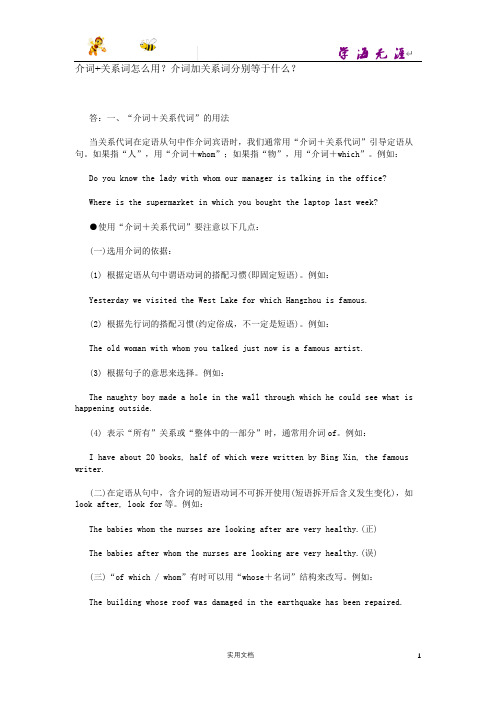
介词+关系词怎么用?介词加关系词分别等于什么?答:一、“介词+关系代词”的用法当关系代词在定语从句中作介词宾语时,我们通常用“介词+关系代词”引导定语从句。
如果指“人”,用“介词+whom”;如果指“物”,用“介词+which”。
例如:Do you know the lady with whom our manager is talking in the office?Where is the supermarket in which you bought the laptop last week?●使用“介词+关系代词”要注意以下几点:(一)选用介词的依据:(1) 根据定语从句中谓语动词的搭配习惯(即固定短语)。
例如:Yesterday we visited the West Lake for which Hangzhou is famous.(2) 根据先行词的搭配习惯(约定俗成,不一定是短语)。
例如:The old woman with whom you talked just now is a famous artist.(3) 根据句子的意思来选择。
例如:The naughty boy made a hole in the wall through which he could see what is happening outside.(4) 表示“所有”关系或“整体中的一部分”时,通常用介词of。
例如:I have about 20 books, half of which were written by Bing Xin, the famous writer.(二)在定语从句中,含介词的短语动词不可拆开使用(短语拆开后含义发生变化),如look after, look for等。
例如:The babies whom the nurses are looking after are very healthy.(正)The babies after whom the nurses are looking are very healthy.(误)(三)“of which / whom”有时可以用“whose+名词”结构来改写。
定语从句中的介词可提前的全部情况

定语从句中的介词可提前的全部情况关系代词whom或which在定语从句中作介词宾语时,介词可放在后面,也可提前构成介词+关系代词whom (先行词指人)/which(先行词指物)引导定语从句(这种方法更为正式)。
例: Mary is the girl whom I borrowed a book from. = Mary is the girl from whom I borrowed a book. 玛丽就是我向她借书的那个女孩。
Is this the room that/which he once lived in? = Is this the room in which he once lived? 这是他曾经住过的房子吗?常见的有以下几种情况:1. where=in/on which 例:This is the room where / in which he lives.这是他住的房间。
I can see the playground where / on which they do sports.我能看见他们进行运动的操场。
2. when= on/in/at which 例:I still remember the year when/ in which I joined the Party.我仍然记得入党的那一年。
I still remember the day when/on which I joined the Party. 我仍然记得入党的那一天。
I still remember the hour when/at which the rocket was launched.我仍然记得那个火箭发射的时刻。
3. why=for which 例:This is the reason why / for which he was killed.这是他被杀害的原因。
但下列情况下介词不能提前:⑴用who代替whom,用that代替which时,介词不能提前。
“介词+关系代词”中介词的选用

“介词+关系代词”中介词的选用定语从句是高一英语语法的重难点,同时又是高考必考热点之一。
纵观10年来各地高考试题对定语从句的考查,越来越突出能力立意。
定语从句中关于“介词+关系代词”引导定语从句时介词的选择则更是令众多考生十分头疼的一大难题。
之所以难,主要在于难以选出合适的介词。
而介词的选用是有一定规律的,同学们只要掌握了这些规律,解题时就可迎刃而解,举一反三了。
一、根据定语从句中的线索来选用介词这线索可以是:1.定语从句中的短语动词这是主要线索,所选介词需与动词搭配。
例如:⑴ She paid the man from whom she had borrowed some money.(=She paid the man.She had borrowed some money from him.)(borrow sth.from sb.意思是“向某人借东西”)⑵ In the dark street, there wasn't a single person to whom she could turn for help.(NMET 1992)(turn to sb.for help,意思是“求某人帮助”)在这一句式结构中,句中的介词与从句的谓语动词有一定的搭配关系。
介词可用于关系代词之前,但先行词若指人,关系代词必须用whom,不能用who或that;若指物必须用which,不能用that。
介词也可以置于从句谓语动词之后,这时,句中关系代词用who,whom,that均可,指物可用which或that,并均可省略。
例如:The middle-aged woman to whom I spoke just now is my English teacher.[=The middle-aged (womanwho/whom/that) I spoke to just now is my English teacher.]2.定语从句中的形容词短语所选介词与形容词构成短语。
定语从句介词加关系代词用法

定语从句介词加关系代词用法在定语从句中,介词加关系代词的用法如下:1.关系代词在介词前:当关系代词作为定语从句的主语时,介词通常放在关系代词的前面。
例如:- The man whom I spoke to is my boss.(我与之交谈的那个人是我的老板。
)- The book that I am looking for is on the table.(我要找的那本书在桌子上。
)2.关系代词在介词后:当关系代词作为定语从句的宾语时,介词通常放在关系代词的后面。
例如:- The house which he lives in is very old.(他住在的那栋房子很旧。
)- The car that she is interested in is not available.(她感兴趣的那辆车不可用。
)需要注意的是,当介词后的关系代词是which时,可以省略介词。
例如:- The city which I was born in is famous for its architecture.(我出生的那座城市以其建筑而闻名。
)- The city I was born in is famous for its architecture.(我出生的那座城市以其建筑而闻名。
)同时,也可以通过适当拓展定语从句来提供更多信息:- The man whom I spoke to yesterday, in the cafe near my office, is my boss.(昨天我在我办公室附近的咖啡馆里与之交谈的那个人是我的老板。
)- The book that I am looking for, which is a bestseller,is on the table.(我正在找的那本畅销书就在桌子上。
)。
定语从句介词提前用法

定语从句介词提前用法定语从句是英语中非常重要的一种语法结构,它可以用来修饰名词或代词,进一步描述或限定其所指的对象。
而介词提前则是定语从句中常用的一种表达方式,它可以使句子更加简洁明了,也更符合英语语言的表达习惯。
介词提前的用法可以通过以下例句来理解:1. The book on the table, which I borrowed from the library, is very interesting.这句话中,介词on被提前到定语从句的开头,修饰名词table。
定语从句的主语是I,谓语是borrowed,关系代词which指代的是book。
2. The girl in the red dress, whom I met yesterday, is my new neighbor.这句话中,介词in被提前到定语从句的开头,修饰名词dress。
定语从句的主语是I,谓语是met,关系代词whom指代的是girl。
3. The man with the beard, whose car was stolen, reported thetheft to the police.这句话中,介词with被提前到定语从句的开头,修饰名词beard。
定语从句的主语是car,谓语是was stolen,关系代词whose指代的是man。
通过以上例句可以看出,介词提前的用法可以使定语从句更加简洁明了,同时也可以使句子的语气更加自然流畅。
在实际应用中,我们可以根据需要灵活运用介词提前的用法,使句子更加优美。
除了介词提前,定语从句还有其他的表达方式,比如关系代词的省略、关系代词的替换等。
在使用定语从句时,我们需要注意以下几点:1. 关系代词的选择:在定语从句中,关系代词的选择要根据其在从句中所扮演的角色来确定。
比如,主语要用who或that,宾语要用whom或that,所有格要用whose等。
2. 关系代词的位置:在定语从句中,关系代词的位置要放在从句中所修饰的名词或代词之后,这样才能清晰地表达出其所指代的对象。
定语从句中介词加关系代词的用法
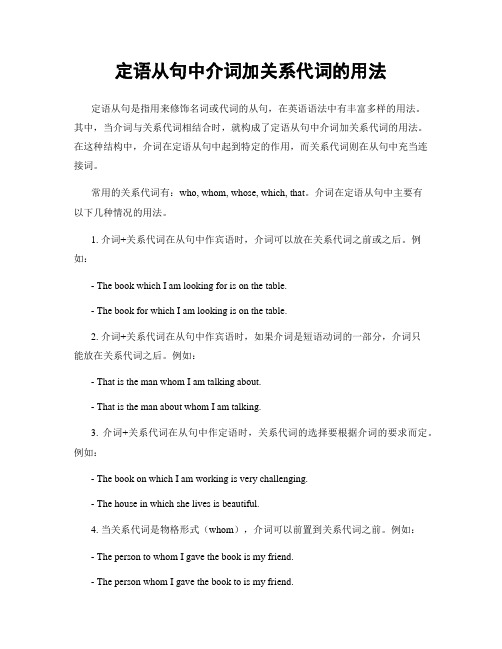
定语从句中介词加关系代词的用法定语从句是指用来修饰名词或代词的从句,在英语语法中有丰富多样的用法。
其中,当介词与关系代词相结合时,就构成了定语从句中介词加关系代词的用法。
在这种结构中,介词在定语从句中起到特定的作用,而关系代词则在从句中充当连接词。
常用的关系代词有:who, whom, whose, which, that。
介词在定语从句中主要有以下几种情况的用法。
1. 介词+关系代词在从句中作宾语时,介词可以放在关系代词之前或之后。
例如:- The book which I am looking for is on the table.- The book for which I am looking is on the table.2. 介词+关系代词在从句中作宾语时,如果介词是短语动词的一部分,介词只能放在关系代词之后。
例如:- That is the man whom I am talking about.- That is the man about whom I am talking.3. 介词+关系代词在从句中作定语时,关系代词的选择要根据介词的要求而定。
例如:- The book on which I am working is very challenging.- The house in which she lives is beautiful.4. 当关系代词是物格形式(whom),介词可以前置到关系代词之前。
例如:- The person to whom I gave the book is my friend.- The person whom I gave the book to is my friend.需要注意的是,在口语中,人们往往更倾向于使用介词后置的形式,即将介词放在关系代词后面。
同时,有时候可以使用介词+which来替代介词+关系代词的结构,这种形式更加简洁。
定语从句的介词用法
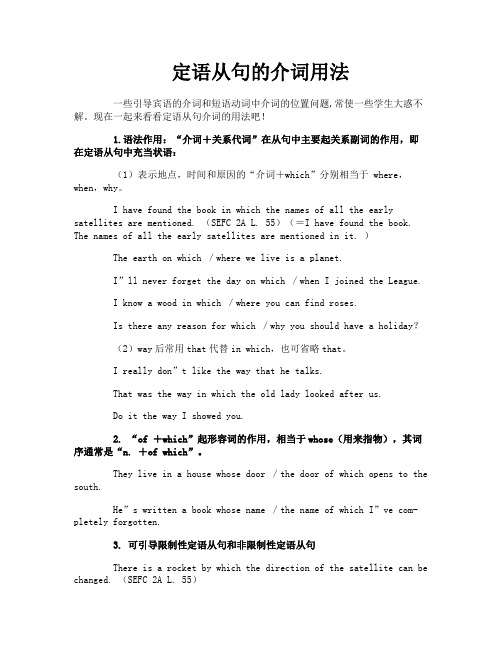
定语从句的介词用法一些引导宾语的介词和短语动词中介词的位置问题,常使一些学生大惑不解。
现在一起来看看定语从句介词的用法吧!1.语法作用:“介词+关系代词”在从句中主要起关系副词的作用,即在定语从句中充当状语:(1)表示地点,时间和原因的“介词+which”分别相当于 where,when,why。
I have found the book in which the names of all the early satellites are mentioned. (SEFC 2A L. 55)(=I have found the book. The names of all the early satellites are mentioned in it. )The earth on which /where we live is a planet.I”ll never forget the day on which /when I joined the League.I know a wood in which /where you can find roses.Is there any reason for which /why you should have a holiday?(2)way后常用that代替in which,也可省略that。
I really don”t like the way that he talks.That was the way in which the old lady looked after us.Do it the way I showed you.2. “of +which”起形容词的作用,相当于whose(用来指物),其词序通常是“n. +of which”。
They live in a house whose door /the door of which opens to the south.He”s written a book whose name /the name of which I”ve com- pletely forgotten.3. 可引导限制性定语从句和非限制性定语从句There is a rocket by which the direction of the satellite can be changed. (SEFC 2A L. 55)We carefully studied the photos,in which we could see signs of plant disease. (SEFC 2A L. 55)4. 介词的选择(选择介词时须考虑下列情况)1)介词与先行词的习惯搭配There is no way in which it could be brought back to the earth. (SEFC 2A L. 55)(in与way是习惯搭配)2)介词与定语从句中的动词,形容词的习惯搭配These are the wires with which different machines are connected. (be connected with是习惯搭配)The author with whom all of us are familiar will visit our compa-ny. (be familiar with是习惯搭配)3)同形的先行词,或定语从句中的动词,形容词表示不同的含义时,要根据其含义选用不同的介词。
带介词的定语从句解释
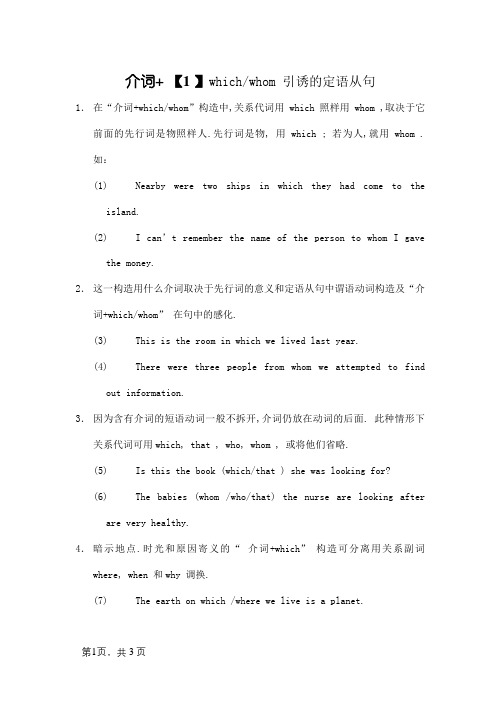
介词+ 【1 】which/whom 引诱的定语从句1.在“介词+which/whom”构造中,关系代词用which 照样用whom ,取决于它前面的先行词是物照样人.先行词是物, 用which ; 若为人,就用whom .如:(1)Nearby were two ships in which they had come to theisland.(2)I can’t remember the name of the person to whom I gavethe money.2.这一构造用什么介词取决于先行词的意义和定语从句中谓语动词构造及“介词+which/whom”在句中的感化.(3)This is the room in which we lived last year.(4)There were three people from whom we attempted to findout information.3.因为含有介词的短语动词一般不拆开,介词仍放在动词的后面. 此种情形下关系代词可用which, that , who, whom , 或将他们省略.(5)Is this the book (which/that ) she was looking for?(6)The babies (whom /who/that) the nurse are looking afterare very healthy.4.暗示地点.时光和原因寄义的“介词+which”构造可分离用关系副词where, when 和why 调换.(7)The earth on which /where we live is a planet.(8)I’ll never forget the day on which /when I joined theLeague.(9)Is there any reason for which /why you should have aholiday?5.Of which可以代替whose 用来指物, 其词序一般为“名词+ of which”(10)They live in a house whose door/the door of which opensto the north.(11)He has written a book whose name /the name of which I’vecompletely forgotten.6.“庞杂介词 in front of, at the back of , on the top of, in the middle of 等+ which”构造可引诱非限制性定语从句.(12)He works in a factory, in front of which there is a river.(13)In the evening we arrived at a hill, at the foot of whichthere was a temple.7.“介词+which/ whom”构造中的which 和 whom 不克不及调换为that, 因为that 不克不及做介词宾语.假如用that ,介词必须重复到从句有关动词的后面去.(14)The room that/which he lives in is a small one.(15)The room in which he lives is a small one.8.在有定语从句的句子里,先行词way 后经常应用that 代替in which, 也可把that省略.(16)I really don’t like the way (that/ in which ) he talks.(17) Do it the way I showed you.带介词的定语从句翻译演习15句1.The girl for whom you bought the dress is in the hospital.2.The professor with whom you talked just now is in the office.3.The ice on which you skate must be very hard.4.The town around which I will show you is very beautiful.5.The satellite for which the rocket is built will be sent into space.6.The photos in which we found some information are kept in his box.7.The country from which this news is coming from is very rich.8.This is the river from which the electricity is made.9.This is the pilot from whom I got the pictures.10.The room in which we took pictures are dusty.11.There is a train by which you can go to Beijing.12.There is no way in which you can solve the problem.13.They went to the library from which they borrowed a lot ofbooks.14.We carefully examined the photo, in which we could see thesadness of the actor.15.The balloon in which we travelled was filled with hot air.。
定语从句“介词+关系代词+不定式”用法-初中英语语法
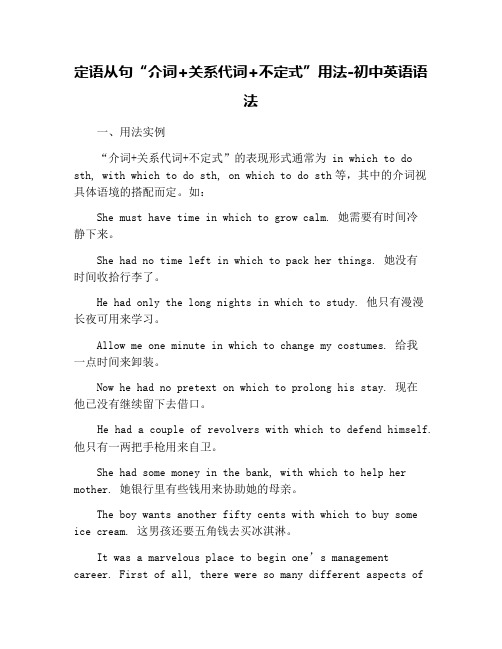
定语从句“介词+关系代词+不定式”用法-初中英语语法一、用法实例“介词+关系代词+不定式”的表现形式通常为 in which to do sth, with which to do sth, on which to do sth等,其中的介词视具体语境的搭配而定。
如:She must have time in which to grow calm. 她需要有时间冷静下来。
She had no time left in which to pack her things. 她没有时间收拾行李了。
He had only the long nights in which to study. 他只有漫漫长夜可用来学习。
Allow me one minute in which to change my costumes. 给我一点时间来卸装。
Now he had no pretext on which to prolong his stay. 现在他已没有继续留下去借口。
He had a couple of revolvers with which to defend himself. 他只有一两把手枪用来自卫。
She had some money in the bank, with which to help her mother. 她银行里有些钱用来协助她的母亲。
The boy wants another fifty cents with which to buy some ice cream. 这男孩还要五角钱去买冰淇淋。
It was a marvelous place to begin one’s management career. First of all, there were so many different aspects oftransport on which to try my hand. 这是开始一个人的经营管理生涯的好地方。
定语从句中介词+关系词的用法
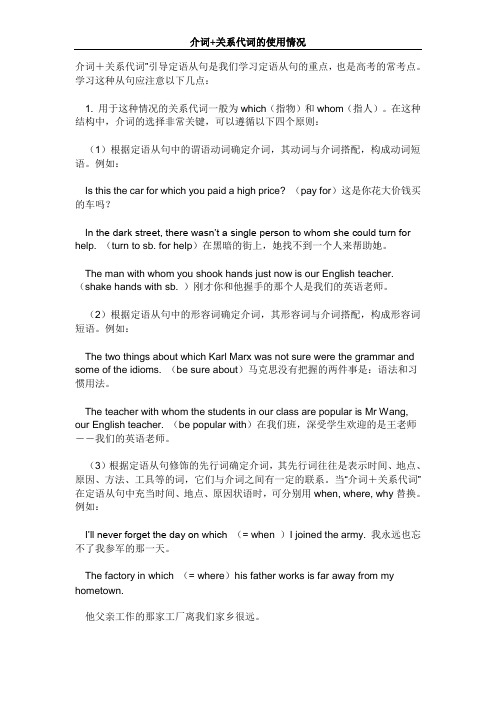
介词+关系代词”引导定语从句是我们学习定语从句的重点,也是高考的常考点。
学习这种从句应注意以下几点:1. 用于这种情况的关系代词一般为which(指物)和whom(指人)。
在这种结构中,介词的选择非常关键,可以遵循以下四个原则:(1)根据定语从句中的谓语动词确定介词,其动词与介词搭配,构成动词短语。
例如:Is this the car for which you paid a high price? (pay for)这是你花大价钱买的车吗?I n the dark street, there wasn’t a single person to whom she could turn for help. (turn to sb. for help)在黑暗的街上,她找不到一个人来帮助她。
The man with whom you shook hands just now is our English teacher. (shake hands with sb. )刚才你和他握手的那个人是我们的英语老师。
(2)根据定语从句中的形容词确定介词,其形容词与介词搭配,构成形容词短语。
例如:The two things about which Karl Marx was not sure were the grammar and some of the idioms. (be sure about)马克思没有把握的两件事是:语法和习惯用法。
The teacher with whom the students in our class are popular is Mr Wang, our English teacher. (be popular with)在我们班,深受学生欢迎的是王老师--我们的英语老师。
(3)根据定语从句修饰的先行词确定介词,其先行词往往是表示时间、地点、原因、方法、工具等的词,它们与介词之间有一定的联系。
定语从句:介词语法
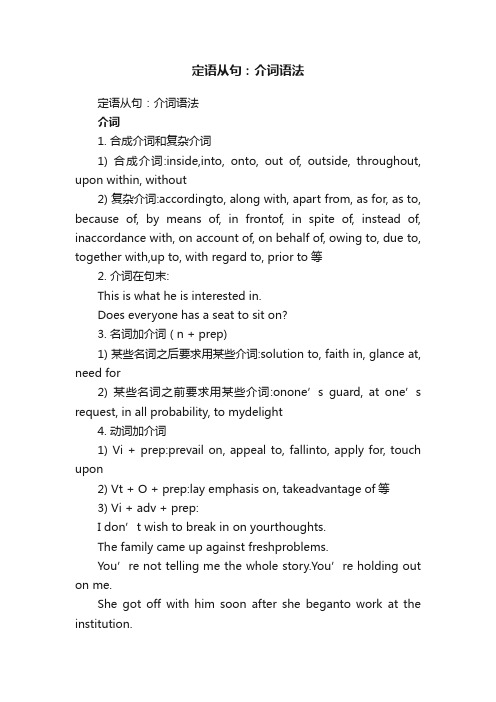
定语从句:介词语法定语从句:介词语法介词1. 合成介词和复杂介词1) 合成介词:inside,into, onto, out of, outside, throughout, upon within, without2) 复杂介词:accordingto, along with, apart from, as for, as to, because of, by means of, in frontof, in spite of, instead of, inaccordance with, on account of, on behalf of, owing to, due to, together with,up to, with regard to, prior to等2. 介词在句末:This is what he is interested in.Does everyone has a seat to sit on?3. 名词加介词 ( n + prep)1) 某些名词之后要求用某些介词:solution to, faith in, glance at, need for2) 某些名词之前要求用某些介词:onone’s guard, at one’s request, in all probability, to mydelight4. 动词加介词1) Vi + prep:prevail on, appeal to, fallinto, apply for, touch upon2) Vt + O + prep:lay emphasis on, takeadvantage of等3) Vi + adv + prep:I don’t wish to break in on yourthoughts.The family came up against freshproblems.You’re not telling me the whole story.You’re holding out on me.She got off with him soon after she beganto work at the institution.4) Vt + O + adv +prep:You shouldn’t take your resentment out onme.We shouldn’t put the shortage down to badplanning.5. 形容词加介词about---anxious, careful, careless,certain, considerate, enthusiastic, guilty, happy, mad, particular, sad, sure,timid, unhappy, etcat---awkward, bad, clever,disappointed, disgusted, good, marvellous, quick, skilful, skilled, useless,weak, etcfor---convenient, eligible, grateful,homesick, hungry, necessary, noted, perfect, responsible, etc from --- evident,exempt, inseparable, safe, tired, etcin---deficient, expert, liberal, quick,rich, successful, weak, etc of---apprehensive, characteristic,critical, destructive, envious, hard, inconsiderate, impatient, dependent,jealous, positive, scared, sensible, short, sick, suspicious, typical, worthy,etc on---dependent, keen, intent, etcto---acceptable, accessible, agreeable,alive, attentive, blind, comparable, courteous, deaf, destructive, essential,favourable, hostile, indifferent, married, obedient, parallel, preferable,related, responsible, sensitive, suitable, unjust, etcwith---awkward, bored, careful,disappointed, generous, identical, ill, impatient, popular, sick, wrong, etc定语从句1. 限制和非限制性定语从句:限制性定语从句是名词词组不可缺少的一个组成部分, 去掉了会造成病句或意义不明确; 非限制性定语从句属于补充说明性质, 去掉了不会影响主要意义, 通常用逗号与它的先行词分开.The boys who wanted to play football were disappointed when it rained.The boys, who wanted to play football, were disappointed when it rained.如果定语从句的先行词是专有名词, 或是带有形容词性物主代词(my, his, etc)或形容词性指示代词(this, that, etc)作限定词, 其后的定语从句通常都是非限制性的: Mary Smith, who is in the corner, wants to meet you.Her mother, who had long suffered form arthritis, died last night.All these books, which have been donated by visiting professors, are to be used by the postgraduates.在非限制性定语从句中只能用who/whom指人, 用which指物,通常不用that替代.My father, who had been on a visit to America, returned yesterday.All the books, which had pictures in them, were sent to the little girl.2. 定语从句的引导词1) that, who, whom: 非限制性定语从句, 如果修饰人, 一般用who,有时用that (作主语时用who较多). 如果关系代词在从句中作宾语, 就应当用宾格 whom 或that,但在大多数情况下都可以省略掉, 在口语中可用who代替whom.Here is the man (whom) you’ve been looking for.He is a man (that) you can safely depend on.The people (who/that) you were talking to were Swedes.There are some people here who I want you to meet.但在介词后只能用whom:This is the man to whom I referred.但在口语中一般都把介词放到句子后面去, 这时可用that, 但省略时更多一些.Have you met the person about whom he was speaking?Have you met the person (that) he was speaking aboutThe girl to whom I spoke is my cousin.The girl (who/that) I spoke to is my cousin.2) 限制性定语从句如果修饰“物”, 用关系代词that的时候较多, 也有时用which..当这个代词在从句中是用作宾语时, 在绝大多数情况下都是省略的, 特别是口语中(尤其是当被修饰的词是all, everything等词时):Have you everything you need?(Is there) anything I can do for you?All you have to do is to press the button.在介词后只能用which, 在口语中一般都把介词放到从句后部去, 这时可以用that, 但省略的时候更多一些:The tool with which he is working is called a wrench.The tool (that) he is working with is called a wrench.This is the question about which we’ve had so much discussion.This is the question (that) we’ve had so much discussion about.定语从句一般是修饰名词或代词的, 但间或也可以修饰整个句子a), 或是句子的`一部分b), 引导词用which:a) They have invited me to visit their country, which is very kind of them.The activity was postponed, which was exactly what we wantedb) When deeply absorbed in work, which he often was, he would forget all about eating and sleeping.She was very patient towards the children, which her husband seldom was.3) whose: 在表示“...的”这个概念时, 可用所有格whose; whose 用于指物, 有时可与of which交替使用, 通常的词序是名词词组 + of which:Is there anyone in your class whose family is in the northeast?We had a meeting whose purpose was completely unclear. (…the purpose of which was…) He’s written a book the name of which I’ve completely forgotten. (…whose name I’ve…) of which前的名词词组也可以由some, any, none, all, both, several, enough, many, most, few以及基数词担任; 这些词也能用在of whom之前.The buses, most of which were already full, were surrounded by an angry crowd.It’s a family of eight children, all of whom are studying music.4) 关系副词 when, where, why: 它们的含义相当于 at which, in which, for which, 因此它们之间有交替使用的可能.The day when he was born…on which he was born…which he was born on…The office where he works…at which he works…which he works at…有时可用that替代关系副词, 在口语中that可省略.Every time (that) the telephone rings, he gets nervous.This was the first time I had serious trouble with my boss.Do you know anywhere (that) I can get a drink?This is the place (where) we met yesterday.That is the reason (why) he did it.在the way 后也可用that 替代in which, 在口语中that也可省略.This is the way (that/in which) he did it.That’s the way I look at it.3. 如果定语从句中谓语为there is, 作主语的关系代词也常可省掉:I must make full use of the time there is left to me and do as much as I can for the people.This is the fastest train (that) there is to Nanjing.4. 定语从句的简化:定语从句与不定式结构, -ing分词结构, -ed分词结构以及无动词分句等有着转换关系.He was the only one to realize the danger (= who realized the danger).The woman driving the car (= who was driving the car) indicated that she was going to turn left. The man injured by the bullet (= who was injured by the bullet) was taken to hospital.All the women present (= who were present) looked up in alarm.。
带介词的定语从句解释
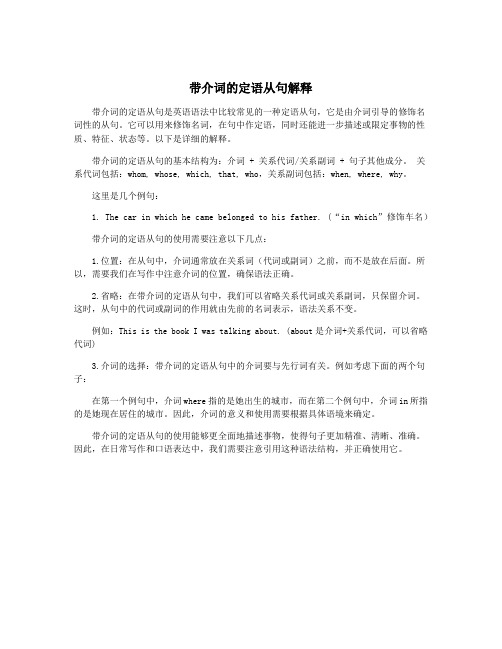
带介词的定语从句解释
带介词的定语从句是英语语法中比较常见的一种定语从句,它是由介词引导的修饰名词性的从句。
它可以用来修饰名词,在句中作定语,同时还能进一步描述或限定事物的性质、特征、状态等。
以下是详细的解释。
带介词的定语从句的基本结构为:介词 + 关系代词/关系副词 + 句子其他成分。
关系代词包括:whom, whose, which, that, who,关系副词包括:when, where, why。
这里是几个例句:
1. The car in which he came belonged to his father. (“in which”修饰车名)
带介词的定语从句的使用需要注意以下几点:
1.位置:在从句中,介词通常放在关系词(代词或副词)之前,而不是放在后面。
所以,需要我们在写作中注意介词的位置,确保语法正确。
2.省略:在带介词的定语从句中,我们可以省略关系代词或关系副词,只保留介词。
这时,从句中的代词或副词的作用就由先前的名词表示,语法关系不变。
例如:This is the book I was talking about. (about是介词+关系代词,可以省略代词)
3.介词的选择:带介词的定语从句中的介词要与先行词有关。
例如考虑下面的两个句子:
在第一个例句中,介词where指的是她出生的城市,而在第二个例句中,介词in所指的是她现在居住的城市。
因此,介词的意义和使用需要根据具体语境来确定。
带介词的定语从句的使用能够更全面地描述事物,使得句子更加精准、清晰、准确。
因此,在日常写作和口语表达中,我们需要注意引用这种语法结构,并正确使用它。
介词后面定语从句

介词后面定语从句介词后面定语从句英语最早被中世纪的英国使用,并因其广阔的殖民地而成为世界使用面积最广的语言。
下面是店铺为大家整理的介词后面定语从句,欢迎阅读与收藏。
1.由“介词+关系代词”引导的定语从句主要用于正式文体,在非正式文体中通常将介词放至句末。
如:This is the man to whom I referred. 我指的就是这个人。
This is the man (whom) I referred to. 我指的就是这个人。
2. 直接用于介词后作宾语的关系代词which不能换成that,直接用于介词后作宾语的关系代词whom不能换成who:介词用于句末,则用作宾语的which, whom也可换成that, who,或者省略不同。
如:这是一个我们讨论了许多的问题。
This is a subject about which we have talked a lot.(which不能换成that,也不能省略)This is a subject which we have talked about a lot. 这是一个我们讨论了许多的`问题。
(which可以换成that,也可以省略)3. 关系副词when, where, why根据情况有时可换成“介词+关系代词which”。
如: That is the day when [=on which] he was born. 那就是他出生的日子。
That is the house where [=in which] he lived. 那就是他住过的房子。
That is the reason why [=for which] he must apologize. 那就是他必须道歉的原因。
4. 在很正式的文体中,“介词+关系代词”引导的定语从句可紧缩成“介词+关系代词+不定式”结构。
如:在那儿孩子们有个玩耍的花园。
正:There the children had a garden in which to play. (很正式)正:There the children had a garden in which they could play. (较正式)正:There the children had a garden to play in. (较口语化)注:这类“介词+关系代词++不定式”结构中的介词不能没有,也不能放在句末。
解读“介词+关系词” 引导定语从句中的介词

“介词+关系词”引导定语从句中的介词(作者独撰)在“介词+ 关系词” 引导定语从句中,关系词主要有which, whom, whose,when,where,它们既可以引导限定性定语从句,也可以引导非限定性定语从句。
应如何确定介词呢?为帮助同学们透彻掌握这一重要的语法现象,本文从八个方面进行了解读,希望对同学们学习这一语法现象有所启发。
一、介词与从句的先行词是习惯搭配当定从的先行词为时间或地点名词(该名词在主句中可充当主语、宾语、补足语、表语或者同位语等)时,应根据定语从句所修饰的名词前习惯搭配的介词来确定关系代词前所选的介词,此时的“介词+ which”代替when/where在从句中做地点或时间状语,该定语从句可以是限制性定从或非限制性定从。
最常见的表示时间的介词有:in, at, on, during, since, by, before, after, until等。
例如:1. This is the house which I lived two years ago.2. Do you remember the day which you joined our club?解析:两题答案分别为in,on;第1小题中先行词house常与in搭配构成介词短语in the house 且在从句中属地点状语,故用in which(=where)引导定语从句,翻译为:这是两年前我住过的房子;第2小题中先行词the day常与on搭配,构成介词短语on the day在从句中属时间状语,故用on which(=when)引导定语从句;译为:你记得你加入俱乐部的那一天吗?二、介词与从句的谓语动词是习惯搭配当定语从句的谓语是动词短语(动词+介词),且先行词在从句中做介词宾语时,该介词可以移到关系代词之前,构成“介词+which /whom”引导的定语从句;但在有些动词短语中,由于动词和介词的关系比较紧密,不能将介词与动词拆开,故不能将介词提到关系代词之前。
定语从句(介词+关系代词)练习
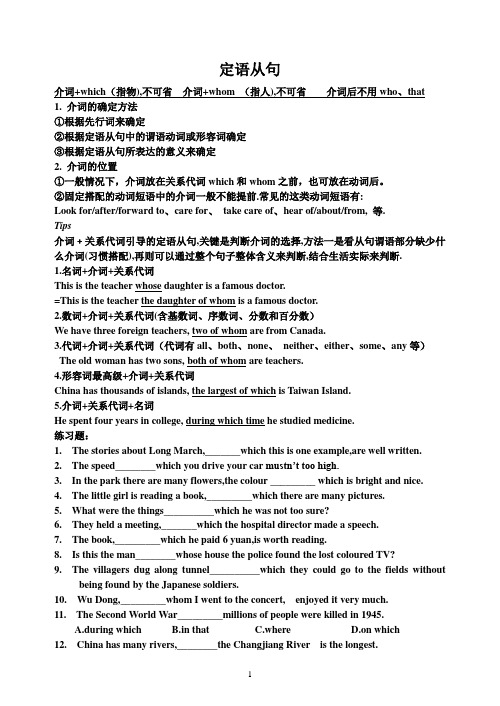
定语从句介词+which(指物),不可省介词+whom (指人),不可省介词后不用who、that1. 介词的确定方法①根据先行词来确定②根据定语从句中的谓语动词或形容词确定③根据定语从句所表达的意义来确定2. 介词的位置①一般情况下,介词放在关系代词which和whom之前,也可放在动词后。
②固定搭配的动词短语中的介词一般不能提前.常见的这类动词短语有:Look for/after/forward to、care for、take care of、hear of/about/from, 等.Tips介词﹢关系代词引导的定语从句,关键是判断介词的选择,方法一是看从句谓语部分缺少什么介词(习惯搭配),再则可以通过整个句子整体含义来判断,结合生活实际来判断.1.名词+介词+关系代词This is the teacher whose daughter is a famous doctor.=This is the teacher the daughter of whom is a famous doctor.2.数词+介词+关系代词(含基数词、序数词、分数和百分数)We have three foreign teachers, two of whom are from Canada.3.代词+介词+关系代词(代词有all、both、none、neither、either、some、any等)The old woman has two sons, both of whom are teachers.4.形容词最高级+介词+关系代词China has thousands of islands, the largest of which is Taiwan Island.5.介词+关系代词+名词He spent four years in college, during which time he studied medicine.练习题:1. The stories about Long March,_______which this is one example,are well written.2. The speed________which you drive your car mustn’t too high.3. In the park there are many flowers,the colour _________ which is bright and nice.4. The little girl is reading a book,_________which there are many pictures.5. What were the things__________which he was not too sure?6. They held a meeting,_______which the hospital director made a speech.7. The book,_________which he paid 6 yuan,is worth reading.8. Is this the man________whose house the police found the lost coloured TV?9. The villagers dug along tunnel__________which they could go to the fields withoutbeing found by the Japanese soldiers.10. Wu Dong,_________whom I went to the concert, enjoyed it very much.11. The Second World War_________millions of people were killed in 1945.A.during whichB.in thatC.whereD.on which12. China has many rivers,________the Changjiang River is the longest.A.whichB. in whichC.among whichD. one of which13. This is the very knife_____I used to cut apples yesterday.A.thatB.by whichC.whichD.with which考点一:that 与which 的区别that 与which 的区别只用that的情况:1. 先行词为all, little, much, everything, nothing, something, anything等不定代词.2.先行词被all, little, much, every, no, 等修饰时。
定语从句中的介词提前
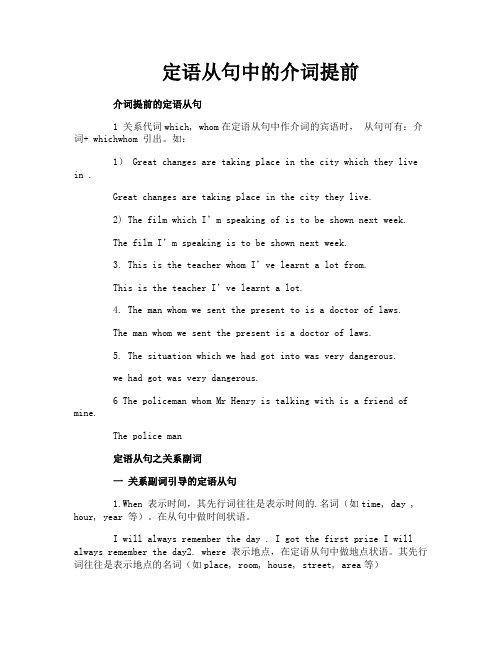
定语从句中的介词提前介词提前的定语从句1 关系代词which, whom在定语从句中作介词的宾语时,从句可有:介词+ whichwhom 引出。
如:1) Great changes are taking place in the city which they live in .Great changes are taking place in the city they live.2) The film which I’m speaking of is to be show n next week.The film I’m speaking is to be shown next week.3. This is the teacher whom I’ve learnt a lot from.This is the teacher I’ve learnt a lot.4. The man whom we sent the present to is a doctor of laws.The man whom we sent the present is a doctor of laws.5. The situation which we had got into was very dangerous.we had got was very dangerous.6 The policeman whom Mr Henry is talking with is a friend of mine.The police man定语从句之关系副词一关系副词引导的定语从句1.When 表示时间,其先行词往往是表示时间的.名词(如time, day , hour, year 等)。
在从句中做时间状语。
I will always remember the day . I got the first prize I will always remember the day2. where 表示地点,在定语从句中做地点状语。
介词引导的定语从句

介词引导的定语从句介词+关系代词引导的定语从句是一种复杂的定语从句形式。
这类定语从句的关系代词包括which、whom和whose,它们既可以引导限定性定语从句,也可以引导非限定性定语从句。
在选择介词时,需要根据不同的语境、语、惯用法等来决定。
介词选择的主要标准如下:1.介词与定语从句的先行词是一种惯性搭配。
例如:___ in the degree to which they can be controlled on purpose.(人类的面部表情和动物的面部表情就可控制的程度来说是不一样的。
)The English play in which my students acted at the New Year’s party was a great success.(那场在新年晚会上我学生参加表演的英语剧很成功。
)___ not all children will be successful in the jobs for which they are being trained.(学校本身承认,并不是所有的孩子都能在他们所接受的培训的职业成功。
)2.介词与定语从句中的动词是一种惯性搭配。
例如:Who is the man with whom our teacher is shaking hands?(我们的老师与之握手的那个男士是谁?)Last month。
part of Southeast Asia was ___。
from whose effects the people are still suffering.(上个月,东南亚的部分地区发生洪水,人们还在遭受着洪水所带来的影响。
)3.介词与定语从句中的形容词构成一种惯性搭配。
例如:This is the book on which I based my research.(这是我研究的依据的那本书。
)The girl to whom he is talking is my sister.(他正在和那个女孩交谈,她是我的妹妹。
“介词 + which whom”引导的定语从句
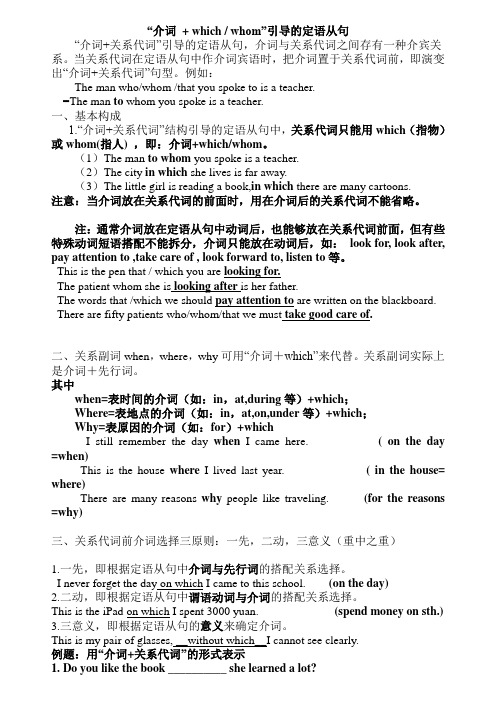
“介词+ which / whom”引导的定语从句“介词+关系代词”引导的定语从句,介词与关系代词之间存有一种介宾关系。
当关系代词在定语从句中作介词宾语时,把介词置于关系代词前,即演变出“介词+关系代词”句型。
例如:The man who/whom /that you spoke to is a teacher.=The man to whom you spoke is a teacher.一、基本构成1.“介词+关系代词”结构引导的定语从句中,关系代词只能用which(指物)或whom(指人) ,即:介词+which/whom。
(1)The man to whom you spoke is a teacher.(2)The city in which she lives is far away.(3)The little girl is reading a book,in which there are many cartoons.注意:当介词放在关系代词的前面时,用在介词后的关系代词不能省略。
注:通常介词放在定语从句中动词后,也能够放在关系代词前面,但有些特殊动词短语搭配不能拆分,介词只能放在动词后,如:look for, look after, pay attention to ,take care of , look forward to, listen to等。
This is the pen that / which you are looking for.The patient whom she is looking after is her father.The words that /which we should pay attention to are written on the blackboard. There are fifty patients who/whom/that we must take good care of.二、关系副词when,where,why可用“介词+which”来代替。
定语从句介词知识点总结

定语从句介词知识点总结介词在定语从句中的使用分为两种情况:一种是介词前置,即介词位于定语从句中引导词的前面;另一种是介词后置,即介词位于定语从句中引导词的后面。
在具体的语境中,要根据不同的情况选择恰当的介词,并确保介词的使用符合语法规则。
一、介词前置情况1. 时间介词的前置在定语从句中,表示时间的介词如at, on, in等通常放在从句的先导词之前。
例如:The day when we met for the first time is still vivid in my memory.(我们第一次见面的那一天在我的记忆中依然清晰)I will never forget the moment when I held my baby for the first time.(我永远不会忘记我第一次抱着我的宝宝的那一刻)2. 原因介词的前置表示原因的介词如because of, due to等也通常放在定语从句中引导词的前面。
例如:The reason why she didn't come to the party is because of her illness.(她没来参加派对的原因是因为生病了)The failure of the project was due to the lack of funding.(这个项目的失败是因为资金不足)3. 地点介词的前置在表示地点的定语从句中,介词如in, at, on等也通常放在引导词的前面。
例如:The place where we met for the first time is now a bustling shopping mall.(我们第一次见面的地方现在成了一个繁华的购物中心)I will never forget the city where I spent my childhood.(我永远不会忘记我度过童年的那座城市)4. 其他介词的前置除了表示时间、原因、地点的介词外,其他表示方式、比较、程度等概念的介词也通常放在定语从句中引导词的前面。
定语从句有介词用that

定语从句有介词用that定语从句中,介词后面能不能加that,定语从句that的用法是如何的呢?定语从句的关系代词that的用法:若先行词指人或物则代替先行词在定语从句中充当主语或宾语The animal that which is lost is a panda.先行词指物代替先行词在定语从句中充当主语She is the person that who we are worried about.先行词指人代替先行词在定语从句中充当宾语注意1 that which在代物时常常可以通用,但有时只宜于用which ,不用that(1) 关系代词前有介词时.This is the hotel in which you will stay.(2) 如有两个定语从句,其中一句的关系代词是that,另一句宜于用which.Let me show you the novel that I borrowed from the liberary which was newly open (新开放) to us.注意2that which在代物时常常可以通用,但有时只宜于用that ,不用which.(1) 先行词是形容词最高级或者它的前面有形容词最高级时This is the best that has been used against air pollution(反对空气污染) in cities.English is the most difficult subject that you will learn during these years.(2) 先行词是序数词,或它的前面有一个序数词时He is the last person that I want to see.(3) 主句中已有疑问词时Which is the bike that you lost?(4) 先行词既有人又有物时The bike and its rider that had run over (撞倒了)an old man were taken to the police station.(5) 先行词是all,much,little,something,everything,anything,nothing,none,the one等代词时You should hand in all that you have.We haven’t got much that we can offer you.I mean the one that you talked about just now.(6) 先行词前面有only,any,few,little,no,all,one of,the same,the very等词修饰时The only thing that we can do is to give you some money.Li Ming is the only one that got full marks (满分)in our class.Li Ming is one of the students that want to be teachers in our class.(7) 有两个定语从句,其中一个关系代词已用which,另外一个宜用thatEdison built up a factory(办了一个工厂) which produced things that had never been seen before.定语从句的关系副词 Where的用法:若先行词指地点且其在定语从句中充当地点状语.This is the house+I was born in the house.(=I was born there) 介词短语副词=This is the house where I was born.这就是我在那儿出生的'房子.先行词关系副词in which I was born.介词+关系代词which I was born in.关系代词这里作介宾的which和that可以省略that I was born in关系代词.that用作先行词时后接定语从句的用法(that which型)当代词that用作先行词后接定语从句时,定语从句通常用关系代词which来引导。
- 1、下载文档前请自行甄别文档内容的完整性,平台不提供额外的编辑、内容补充、找答案等附加服务。
- 2、"仅部分预览"的文档,不可在线预览部分如存在完整性等问题,可反馈申请退款(可完整预览的文档不适用该条件!)。
- 3、如文档侵犯您的权益,请联系客服反馈,我们会尽快为您处理(人工客服工作时间:9:00-18:30)。
定语从句中的介词问题
形容词从句中的介词如何处理,大致可分三种情况。
1.属于: of which/whom = whose
The family lived in an old house.
The roof of the house had fallen in.
先行名词以“of +原词”、或“原词’s” 形式带入从句。
分别对应关系词为of which和whose+名词。
I had many false friends at that time.
One of them betrayed me. (背叛)
先行名词以“of + 原词(人)” 形式带入从句。
对应关系词of whom。
【注】who和whom唯一区别是——前有介词、后接whom。
2.时空: 介+which =where/when
Lin’an is a small city.
I was born in that city.
先行名词以“in + 原词(地点)” 形式带入从句。
对应关系词in which或where。
(我们也可以理解为:先行名词还是原词带入,只是因为介词提前了,所以用which)
【注】that不能代替which的两种情况:1、介词后;2、非限定从句、先行词为前面整个事件(句子)。
3.依此类推:基本原则是用关系词代替先行词,不要打扰介词!
The person should be here soon.
I'm doing the project with him.
先行名词以原词形式带入从句、with提前,只能用whom。
I’d like to thank my father.
I would not have succeeded without his support.
先行名词以“原词’s” 形式带入从句, 前面原本就有个介词without。
His first job is in a big bank.
He learnt a lot of information about financial management from the job.
先行名词以原词形式带入从句。
前面原本就有个介词from。
【技巧小结】
1.无论题目如何复杂,基本原则不变,即:关系词代替先行名词!
2.先行名词在原句中的作用:原词、属格(of型或“‘s“型)、介词宾语。
3.注意that和which、who和whom的适用条件区分。
